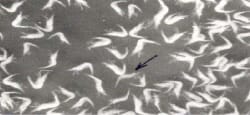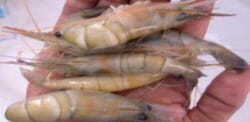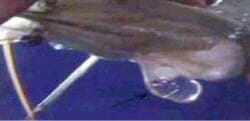The infection was found in the brood stock and F1 juveniles from aquaria in a research facility in Townsville. The wild brood stock were originally sourced from the Flinders River in North Queensland.
The source of the outbreak is unknown at present, but the OIE said there are no control measures to put in place and vaccination is prohibited. However, the disease has also been found in fresh water prawn hatcheries in India.
The disease found in hatcheries at Nellore, Andhra Pradesh and Chennai and it was also reported in some of the farms in Nellore, Andhra Pardesh.
 |
| Fig.1. Hatchery-reared post-larvae of Macrobrachium infected with white tail disease (opaqueness of abdominal muscle)(Picture: Dr Sahul Hameed) |
 |
| Fig. 2. Adult Macrobrachium from grow-out pond infected with white tail disease. (Picture: Dr Sahul Hameed) |
A recent paper by Dr A.S. Sahul Hameed from the Aquaculture Division, Department of Zoology, at C. Abdul Hakeem College, Tamil Nadu, says that as aquaculture expands and intensifies, more and more new diseases will emerge.
Dr Sahul Hameed said that until recently freshwater prawns, Macrobrachium rosenbergii, were regarded as disease resistant, but the report of white tail disease in freshwater prawn hatcheries and farms, sent shock waves through the prawn aquaculture industry in India.
Dr Sahul Hameed said the clinical signs of the disease observed include lethargy, anorexia and opaqueness of abdominal muscle in post-larvae (Fig.1) and adults (Fig. 2). This opaqueness gradually expands on both sides (anterior and posterior) and leads to degeneration of telson and uropods in severe cases. Some infected animals without uropods have been observed.
Whitish appearance of the tail is the prominent clinical sign, and hence the name.
Death is 100 per cent within two or three days after the appearance of the clinical sign of opaqueness.
Dr Sahul Hameed said that experimental transmission of the disease was carried out in the healthy post-larvae and adult Macrobrachium rosenbergii by immersion and intramuscular injection, respectively with homogenized samples prepared from infected animals.
"The cumulative mortality reached 100 per cent in post-larvae within four days," Dr Sahul Hameed said in his paper.
"The clinical signs observed in experimental infection were found to be similar to that of natural infection.
"The experimentally infected adults became lethargic and anorexic.
"Mortality up to 50 per cent was observed within five days. The cephalothoracic region increased in size and it became double of the original size. This sign was observed in all the experimentally infected animals (both survived and moribund animals). Similar clinical signs, (referred to as branchiostegite blister disease (BBD) or swollen head syndrome) accompanied by mortalities, have been reported from adults in grow out farms.
 |
| Fig. 3. Experimentally infected Macrobrachium with sac-like structure. (Picture: Dr Sahul Hameed). |
"The cephalothoracic region when opened had two water sac-like structures with watery fluid above the hepatopancreas on either side (Fig. 3).
Two viruses, Macrobrachium rosenbergii nodavirus (MrNV) and extra small virus (XSV) have been found to be associated with white tail disease and the causative organism has been identified as Macrobrachium nodavirus (MrNV) by RT-PCR in Dr.Bonami's Lab, according to Dr Sahul Hameed.
Now, genome based detection methods for MrNV and XSV have been developed.
Dr Sahul Hameed said that as there are no treatments to viral pathogens, the spread and impact of White Tail Disease can only be lessened by adopting better management practices in hatcheries and farms.

